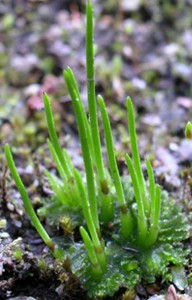As someone who has used taxpayers’ money to fund research on bryophytes (the collective term for mosses, liverworts and hornworts), ‘But why do bryophytes actually matter?’ is one of those questions you start to dread. Admittedly it’s not one everyone asks, presumably as many people haven’t realised that there IS a collective term for mosses, liverworts and hornworts. Or possibly because most people have never heard of hornworts at all…. But when we’re competing, for a limited amount of funding, with people who are trying to increase the productivity of wheat, or the nutrient content of rice, or the number of different kinds of chocolate plant, there’s an onus to justify our research. There’s a good stock of standard answers, but although bryophytes are important in nutrient cycling, and although they have all sorts of wonderful secondary chemicals that just might cure cancer, and although they have an understated sort of beauty that comes alive under the lens of a good close-up photographer (a group from which I am entirely and utterly excluded), we don’t eat them. We don’t wear them, we don’t build with them, drink them, feed them to farm animals, power our cars with them. It could be argued that we can use them as fuel, although it’s hard for a bryologist to seriously advocate peat as a major fuel, mainly a) because wars don’t tend to be fought over bogland in the same way as they are over oilfields, and b), fossil fuels are not exactly the greenest deal.
So why should we care? The converse is simply, ‘Why shouldn’t we?’ – bryophytes represent up to 7/8 of all the evolutionary diversity of land plants. Although they never get very large, they are nearly ubiquitous, present in almost all environments (they don’t grow in the sea). They share most of their genes with other land plants, and there is evidence that genes can have the same functions in mosses (Physcomitrella) and mustards (Arabidopsis). We can use them to advance our knowledge of genetics, a field in which bryophyte studies have led to many important discoveries; this is aided by the fact that the green leafy part of a bryophyte only contains one set of chromosomes (it is haploid), unlike ourselves, or all other land plants, where the green leafy parts have two chromosome copies (they are diploid). A diploid organism contains genes from both of its parents, and how it looks can be an interaction of both genes (like lots of the genes that are responsible for how tall we are), or because one gene is stronger (dominant) than the other (recessive) (a common examples is our brown and blue eye colours). A haploid organism’s appearance is linked far more directly to the genes it contains – if a gene has a mutation, then the result of the mutation can be seen directly – so if a bryophyte gene that let it make little rootlets (rhizoids) got switched off, then the plant wouldn’t be able to make rootlets, and neither would any of its offspring.
In this week’s copy of PNAS is another reason to care about, and conserve, biodiversity regardless of whether we can put an immediate monetary value or use on it – the story, lead-authored by Duke graduate student Fay-Wei Li, of the serendipitous transfer of a gene from a bryophyte to a fern that allowed the subsequent evolutionary radiation of ferns in low-light habitats. Recent genetic work has shown that some plants have a very particular photoreceptor gene that allows them to utilise both red and blue light. Usually, genes are transferred ‘vertically’ – from parent to child (or seed). Very rarely scientists find evidence of ‘horizontal’ transfer, which means that the gene moves sideways and is then passed on to the next generation, as if a virus were to take part of your DNA and put it into the person sitting next to you at lunch, and that person were then to pass it to their child. This is very very very unlikely – but sometimes, it’s the best explanation for a genetic pattern. And in this particular case, if a hornwort had not evolved a red-blue light photoreceptor, and if that changed photoreceptor had not been transfered into ferns, then the diversity of ferns that we see today probably would not have occurred.
Of course, there’s still the question of ‘Why do ferns matter?’ They’re bigger than bryophytes, and people grow them in their gardens, in shady spots that most flowering plants struggle in. People can eat them too. I tried them, once, in New England, and discovered that they taste just like I expected them to taste. I have subsequently stuck to asparagus, superficially ferny looking but a great deal more delicious. Ferns and croziers appear in art, architecture and fashion; Victorians got themselves into frenzies collecting them; in fact they’re all in all a good deal easier to ‘justify’ than bryophytes.
(And for anyone who is not convinced about the value of ferns, my next offering is orchids – a sometimes flamboyant group of over-evolved flowers with dusty seeds so small they need nutrients from a fungal friend to get established. Weirdly, they can use the same fungal partner, Tulasnella, as liverwort genus Aneura.)
With thanks to Juan Carlos Villarreal for the PNAS reprint: Horizontal transfer of an adaptive chimeric photoreceptor from bryophytes to ferns, by Fay-Wei Li, Juan Carlos Villarreal, ………… & Kathleen M. Pryer


2 Comments
2 Pingbacks